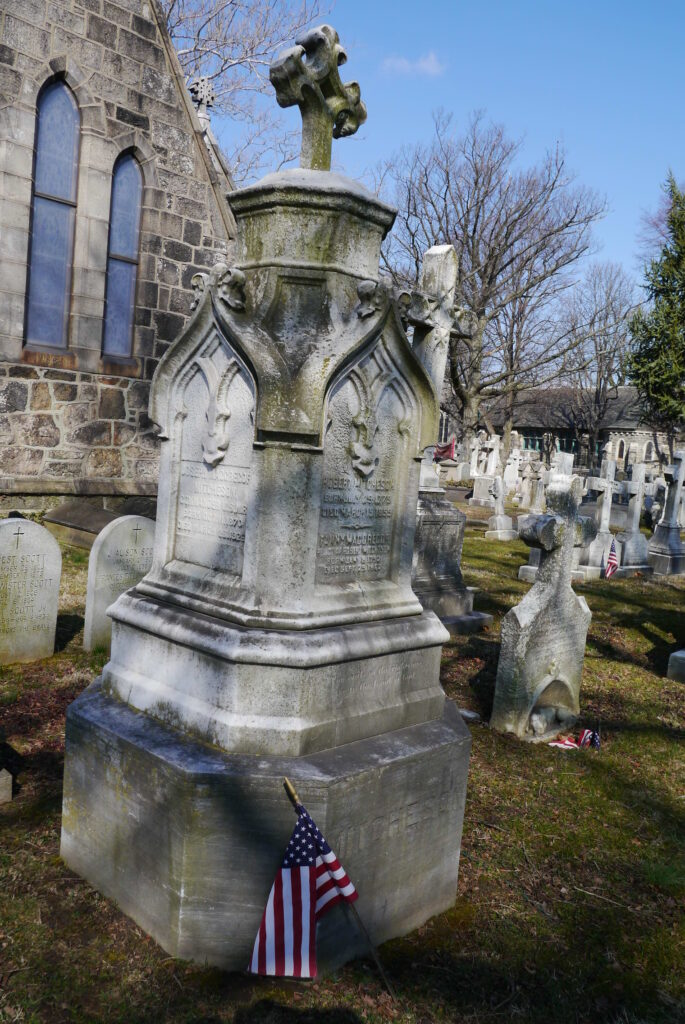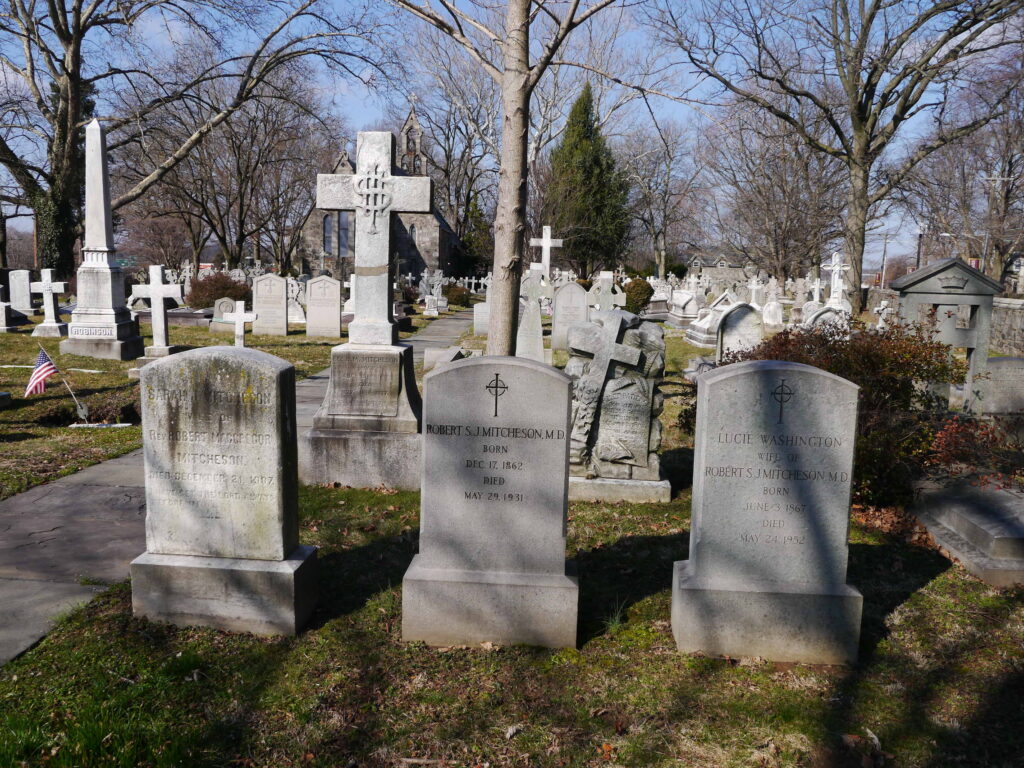If St. James the Less Episcopal Church looks like a little piece of England transplanted across the Atlantic, it is supposed to give that impression. This U.S. National Historic Landmark, with gray stone walls and arched red doors, was patterned after an English parish church and was built in 1846 to serve the families who lived in what was then a rural area near Philadelphia. Robert Mitcheson, my great-great-great grandfather, helped found St. James the Less. Perhaps it reminded him of the church near Durham, England, where he was baptized.
Eventually many members of his family were buried in St. James the Less Cemetery. The Mitchesons purchased two plots, each of which includes a tall monument and several other gravestones. One plot was for merchant Robert Mitcheson (1779-1859) and his wife, Mary Frances (Fanny) McGregor (1792-1862) and several of their children and grandchildren. The other was for their son, Reverend Robert McGregor Mitcheson and his family.

When my husband and I visited Philadelphia last spring, that cemetery visit was one of two priorities. I also wanted to do some research at the Historical Society of Pennsylvania (HSP), a four-storey red brick building on downtown Locust Street that houses a vast collection of historical and genealogical documents.
I had been unable to find a record of Robert’s and Fanny’s marriage, or of their children’s baptisms, online. I still haven’t found the marriage, but I did find the baptismal records in the HSP archives. The couple’s seven children were baptized at St. John’s Protestant Episcopal Church, in the Northern Liberties area north of the city. As far as I know, these records have not been digitized.
But the most interesting discovery I made was that Robert and Fanny may have living descendants in the United States. I am descended from their daughter Catharine, who married Stanley Clark Bagg and moved to his home, Montreal. Most of her descendants are Canadians.
I knew that two of the Mitcheson children died as babies and two others lived to adulthood but had no children. Younger son McGregor J. Mitcheson‘s line died out in 1959. That left oldest son Robert McGregor Mitcheson (1818-1877) and his wife, Sarah Johnson. Their son, Dr. Robert S. J. Mitcheson, was married but childless. Of their two daughters, Helen Patience died young, while Fanny Mary married someone named Smith, so it looked like finding her was going to be a challenge.
A search for Mitcheson in the HSP catalogue brought up one hit: records from the Family Bible of Lloyd Jones and his wife, Eliza Loxley. When I opened the document, I had to smile. Fanny Mary Mitcheson (1851-1937) married Uselma Clarke Smith Jr. (1841-1902), and their descendants appear to have spread across the United States, from Long Island to Chicago and California.

Research notes: When I first started researching several years ago, very few Philadelphia records had been digitized. That situation has improved, and I eventually found Frances Mitcheson’s 1862 death certificate at www.FamilySearch.org. That certificate revealed that Fanny was buried in St. James the Less Cemetery. The statement that Robert Mitcheson helped to found the church comes from an article about his son, lawyer McGregor J. Mitcheson, in Historical Catalogue of the St. Andrews Society of Philadelphia, With Biographical Sketches of Deceased Members.
If you had ancestors in the mid-Atlantic United States, you should try to visit the Historical Society of Pennsylvania, but be well prepared. The library is huge and it can be overwhelming if you don’t have a good idea what you are looking for. The society’s website is www.hsp.org.
As for St. James the Less Church, it is now associated with St. James School, a small middle school serving students from the surrounding disadvantaged neighbourhood. When the head of the school showed us around the cemetery, he told us there was a dispute between the congregation and the diocese several years ago. Had we come then, we would have found the church abandoned and the graveyard overgrown. Now the former parish hall has been converted to classrooms and the cemetery is well maintained. The school’s website, www.stjamesphila.org, has more information about this historic building and the political figures, businessmen and Civil War Union Army officers buried there.
